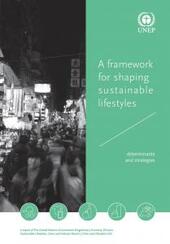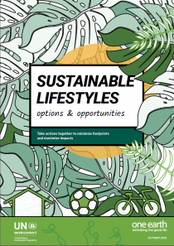Sustainable Lifestyles Resources
A Framework for Shaping Sustainable Lifestyles:
Determinants and Strategies

People make hundreds of thousands of decisions during the course of their lives. For the lucky among us, those decisions will vary widely. No matter how we choose, the lifestyles we end up living – or, in some cases, are forced to live – have a profound impact on our planet, affecting everything from how our economies run to the health of our environment. How we choose to live as a society and as individuals – what houses we choose and build, what food we eat and grow, how we spend our spare time, and what type of transport we use – will have an enormous impact on the trajectory of human history. This publication will help policymakers, individuals and other stakeholders understand what a holistic approach to lifestyle means and how different contexts require different lifestyle solutions. This publication does not set out to define what “the” sustainable lifestyle looks like. Instead, it can help guide a range of initiatives that enable lifestyle choices that contribute to sustainability
1.5 Degree Lifestyles:
Targets and options for reducing lifestyle carbon footprints

This report demonstrates that changes in consumption patterns and dominant lifestyles are a critical and integral part of the solutions package to addressing climate change. The report fills a gap in the existing research by establishing global targets for lifestyle carbon footprints, examining current consumption patterns and their impacts on footprints, and evaluating potential reduction impacts of low-carbon lifestyle options. The results of the analysis are striking, showing in some cases the need for reductions of over 80% in greenhouse gas emissions (GHG) by 2050 from today’s intensity of lifestyles. Reductions will be necessary not only for developed countries; several developing countries will also need to reduce their average per capita emissions from current levels – a significant challenge where the basic needs of large parts of their populations are often still not met. However, as also identified in the report, there are clear opportunities for much needed changes, and these would require that actions start as soon as possible.
The report proposes globally unified per capita targets for the carbon footprint from household consumption for the years 2030, 2040 and 2050. It estimates current average carbon footprints of Finland and Japan, as well as Brazil, India, and China, focusing on the comparison of the level of physical consumption in order to be both comparable to global targets and compatible with household-level solutions. It also identifies potential options for reducing lifestyle carbon footprints on the basis of the literature and assesses the impact of such options in Finnish and Japanese contexts. It concludes with suggestions and implications in terms of how to proceed towards lifestyles compatible with the 1.5 °C target. As the report only covers the countries given above, similar studies can be expanded to other countries using the methodology, data sources, and results of estimation that are detailed in Annexes.
The report proposes globally unified per capita targets for the carbon footprint from household consumption for the years 2030, 2040 and 2050. It estimates current average carbon footprints of Finland and Japan, as well as Brazil, India, and China, focusing on the comparison of the level of physical consumption in order to be both comparable to global targets and compatible with household-level solutions. It also identifies potential options for reducing lifestyle carbon footprints on the basis of the literature and assesses the impact of such options in Finnish and Japanese contexts. It concludes with suggestions and implications in terms of how to proceed towards lifestyles compatible with the 1.5 °C target. As the report only covers the countries given above, similar studies can be expanded to other countries using the methodology, data sources, and results of estimation that are detailed in Annexes.
Sustainable Lifestyles:
Options & Opportunities

This publication offers proven actions for creating and inspiring more sustainable lifestyles. It provides the rationale, resources and ideas for developing initiatives across areas of food, mobility, housing, goods and leisure as well as in general sustainable lifestyle areas. Informed by international advisors including in Bogota and Marrakech, it’s a tool for groups with limited resources who want maximum impact.
Globally, people are weaving sustainability into their daily lives — meeting needs and pursuing wellbeing and aspirations through building community; reducing meat and dairy consumption; wasting less food and using leftovers; reusing, repairing, recycling, sharing and borrowing goods; and enjoying the things that matter most, such as friends, experiences and nature. This is impressive since aspirations of ‘the good life’ continue to be strongly influenced by pro-consumption messaging and because people who are aware may not have more sustainable options available. Yet, taken together these actions are piecemeal and do not capture the full potential that holistic sustainable living initiatives can offer. This publication addresses this gap. It provides a sample of proven lifestyles options and opportunities including in the areas of food, mobility, housing, consumer goods, and leisure and general sustainable lifestyles. The audience is people running campaigns and initiatives with limited resources who want maximum impact. Explore these opportunities and create initiatives that work in your context — because what works in Brazil is different from what works in Morocco. Join us in advancing sustainable living in more effective ways.
Globally, people are weaving sustainability into their daily lives — meeting needs and pursuing wellbeing and aspirations through building community; reducing meat and dairy consumption; wasting less food and using leftovers; reusing, repairing, recycling, sharing and borrowing goods; and enjoying the things that matter most, such as friends, experiences and nature. This is impressive since aspirations of ‘the good life’ continue to be strongly influenced by pro-consumption messaging and because people who are aware may not have more sustainable options available. Yet, taken together these actions are piecemeal and do not capture the full potential that holistic sustainable living initiatives can offer. This publication addresses this gap. It provides a sample of proven lifestyles options and opportunities including in the areas of food, mobility, housing, consumer goods, and leisure and general sustainable lifestyles. The audience is people running campaigns and initiatives with limited resources who want maximum impact. Explore these opportunities and create initiatives that work in your context — because what works in Brazil is different from what works in Morocco. Join us in advancing sustainable living in more effective ways.


